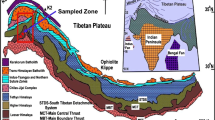Abstract
Four muscovite-biotite granites from the Western Metamorphic Belt of South-eastern Australia have rare earth element patterns characterized by: (i) light rare earth element enrichment; (ii) slight Eu depletion; (iii) varying degrees of heavy rare earth element depletion. The rare earth element and major element chemistry of three of these muscovite-biotite granites (the Koetong, Lockharts and Yabba Granites) can be approximated very closely by a model involving 20% partial melting of an ultrametamorphosed pelitic sediment and contamination of this minimum melt by the residual material left after melting, in the ratio 60% melt: 40% residue. Granitoids can be very largely solid material at the time of emplacement.
The other muscovite-biotite granite studied (the Hawksview Granite) has major and trace element characteristics which distinguish if from the other three granitoids and these differences are attributed to variations in source material at the site of melt generation.
The rare earth element and major element chemistry of a garnet-cordierite gneiss from the Western Metamorphic Belt can be modelled assuming 5% partial melting of a pelitic metamorphic rock and contamination of the minimum melt by the residue in the ratio 30% melt: 70% residue.
Separated granitic and biotitic portions of a migmatite from the Western Metamorphic Belt have rare earth element characteristics which are inconsistent with a simple partial-melting model, but it is suggested that re-equilibration following, or during, separation of the vein material could obscure the process by which the vein of the migmatite developed. It is however certain that the vein developed in situ from a pelitic meta-sediment leaving the biotite rich selvage, without the introduction of material from an external source.
Leucogranites which crop out to the east of the Western Metamorphic Belt are high level intrusions of highly fractionated granitic melt. Their Sr isotopic characteristics and features of their major and trace element chemistry suggest that they derive from an igneous source and are not directly related to the granites and gneisses to the west.
Similar content being viewed by others
References
Brooks, C., Leggo, M.D.: The local chronology and regional implications of a Rb-Sr investigation of granitic rocks from the Corryong district, South-eastern Australia. J. Geol. Soc. Australia 19, 1–19 (1972)
Brown, G.C., Fyfe, W.S.: The production of granitic melts during ultrametamorphism. Contrib. Mineral. Petrol. 28, 310–318 (1970)
Chappell, B.W., White, A.J.R.: Two contrasting granite types. Pacific Geol. 8, 173–174 (1974)
Fyfe, W.S.: Some thoughts on granitic magmas. In: Mechanism of igneous intrusion (G. Newall, N. Rast, eds.). Geol. J., Special Issue No. 2 (1970)
Gast, P.W.: Trace elements fractionation and the origin of tholeiitic and alkaline magma types. Geochim. Cosmochim. Acta 32, 1057–86 (1968)
Griffin, T.J., White, A.J.R., Chappell, B.W.: Moruya Batholith. J. Geol. Soc. Aust. (in press 1977)
Haskin, L.A., Frey, F.A., Schmitt, R.A., Smith, R.H.: Meteoritic, solar and terrestrial rare-earth distributions. Phys. Chem. Earth 7, 167–321 (1966)
Hine, R., Williams, I.S., Chappell, B.W., White, A.J.R.: Geochemical contrasts between I- and S-type granitoids of the Kosciusko Batholith. J. Geol. Soc. Australia, (in press 1977)
Joplin, G.A.: An apparent magmatic cycle in the Tasman Geosyncline. J. Geol. Soc. Australia. 9, 51–70 (1962)
Kolbe, P., Taylor, S.R.: Major and trace element relationships in granodiorites and granites from Australia and South Africa. Contrib. Mineral. Petrol. 12, 202–222 (1966a)
Kolbe, P., Taylor, S.R.: Geochemical investigation of the granitic rocks of the Snowy Mountains area, New South Wales. J. Geol. Soc. Australia 13, 1–25 (1966b)
McKay, W.J.: Metamorphic and igneous rocks from the Tallangatta Region, N.E. Victoria. Unpub. B.Sc. (Hons.) thesis, Aust. Nat. Univ., Canberra (1969)
Miyashiro, A.: Evolution of metamorphic belts. J. Petrol. 2, 277–311 (1961)
Nance, W.B., Taylor, S.R.: Rare earth element patterns and crustal evolution-I. Australian post-Archaen sedimentary rocks. Geochim. Cosmochin. Acta (in press 1976)
Nesbitt, H.W.: Generation of granitic melts by partial fusion of greywacke: Evidence from the chemistry of natural rocks. Contrib. Mineral. Petrol. (in press 1977)
Norrish, K., Chappell, B.W.: X-ray fluorescence spectrography. In: Physical methods in determinative mineralogy (J. Zussman, ed.). London: Academic Press 1967
Norrish, K., Hutton, J.T.: An accurate X-ray spectrographic method for the analysis of a wide range of geilogical samples. Geochim. Cosmochim. Acta 33, 431–454 (1969)
Pettijohn, F.J.: Sedimentary rocks, 2nd edn. Harper 1957
Pigeon, R.T., Compston, W.: The age and origin of the Cooma Granite and its associated metamorphic zones, New South Wales. J. Petrol. 6, 193–222 (1965)
Schnetzler, C.C., Philpotts, J.A.: Partition coefficients of rare-earth elements between igneous matrix material and rock-forming mineral phenocrysts — II. Geochim. Cosmochim. Acta 34, 331–340 (1970)
Shaw, D.M.: Trace element fractionation during anatexis. Geochim. Cosmochim. Acta 34, 237–243 (1970)
Tattam, C.M.: The metamorphic rocks of North-east Victoria. Geol. Surv. Vic. Bull. 52 (1929)
Taylor, S.R.: Geochemical analysis by spark source mass spectrography. Geochim. Cosmochim. Acta 29, 1243–1261 (1965)
Taylor, S.R.: Geochemical application of spark source mass spectrography — II Photoplate data processing. Geochim. Cosmochim. Acta 35, 1187–1196 (1971)
Taylor, S.R., Ewart, A., Capp, A.C.: Leucogranites and rhyolite: Trace element evidence for fractional crystallization and partial melting. Lithos 1, 179–186 (1961)
Tuttle, O.F., Bowen, N.L.: Origin of granite in the light of experimental studies in the system NaAlSi2O8-KAlSi3O8-SiO2-H2O. Mem. Geol. Soc. Am. 74, (1958)
White, A.J.R., Chappell, B.W.: Ultrametamorphism and granitoid genesis. (In prep.) 1977
White, A.J.R., Chappell, B.W., Branch, C.D.: Classification of granite types according to associated rocks. Abstr. Aust. N.Z. Ass. Advnt. Sci., 37 Congr., Canberra (1964)
White, A.J.R., Williams, I.S., Chappell, B.W.: Geology of the Berridale 1∶100,000 sheet (8625). Geol. Surv. N.S.W. (1976)
Williams, N.L.: Palaeozoic geology of the Bethanga Goldfields Area, N.E. Victoria. Unpub. B.Sc. (Hons.) thesis, Aust. Nat. Univ., Canberra (1969)
Wyllie, P.J., Huang, W., Stern, C.R., Maaløe, S.: Granitic magmas: possible and impossible sources, water contents, and crystallization sequences. Canadian J. Earth Sci. 13, 1007–1019 (1976)
Author information
Authors and Affiliations
Rights and permissions
About this article
Cite this article
Price, R.C., Taylor, S.R. The rare earth element geochemistry of granite, gneiss, and migmatite from the Western Metamorphic Belt of South-eastern Australia. Contr. Mineral. and Petrol. 62, 249–263 (1977). https://doi.org/10.1007/BF00371013
Received:
Accepted:
Issue Date:
DOI: https://doi.org/10.1007/BF00371013



